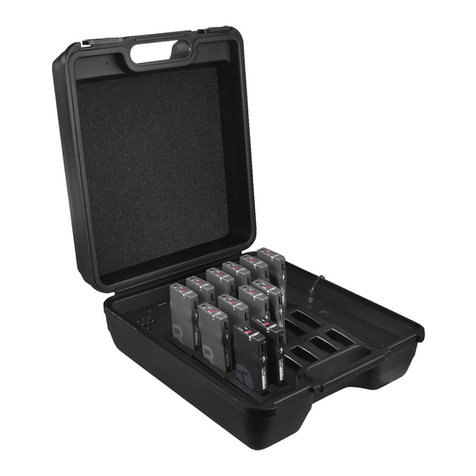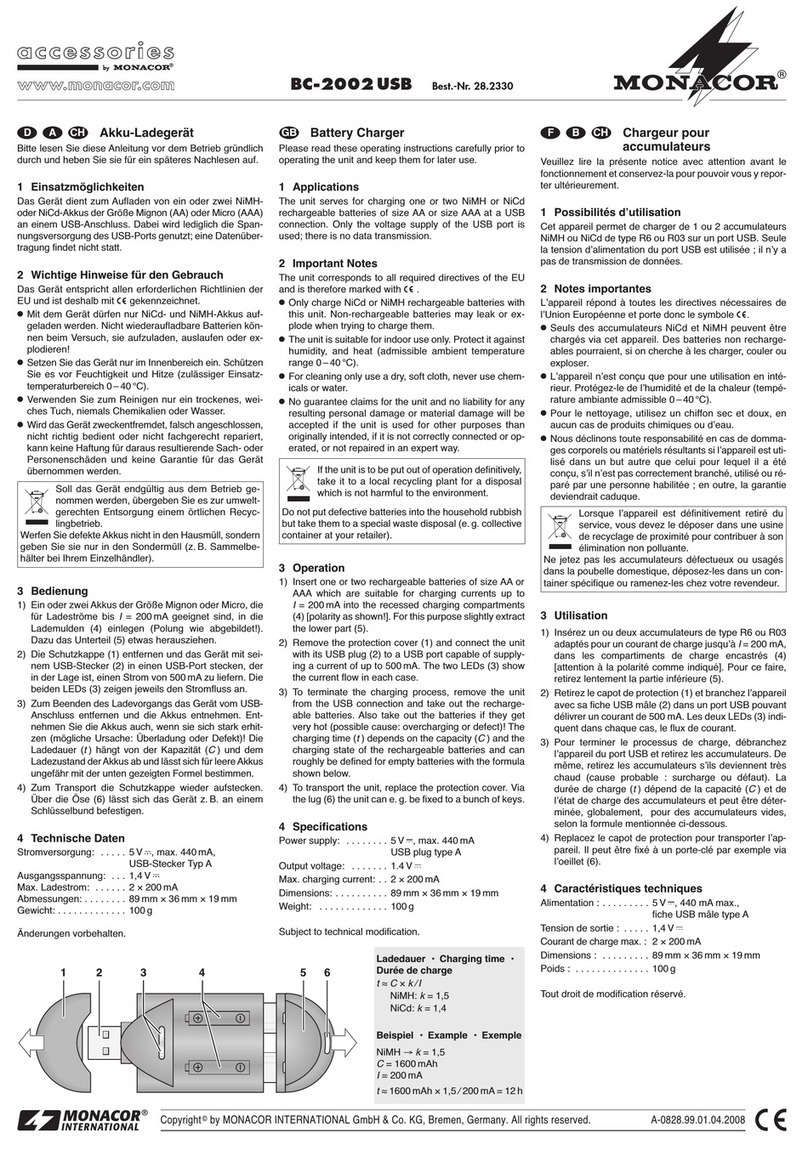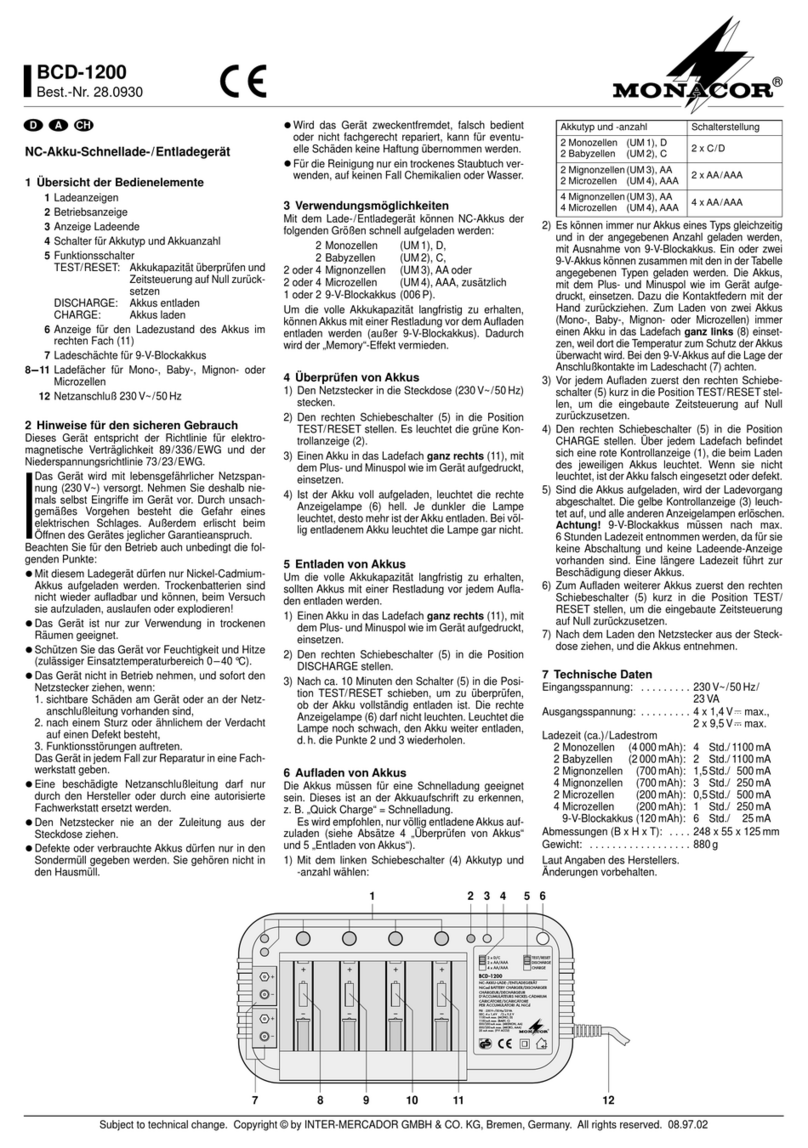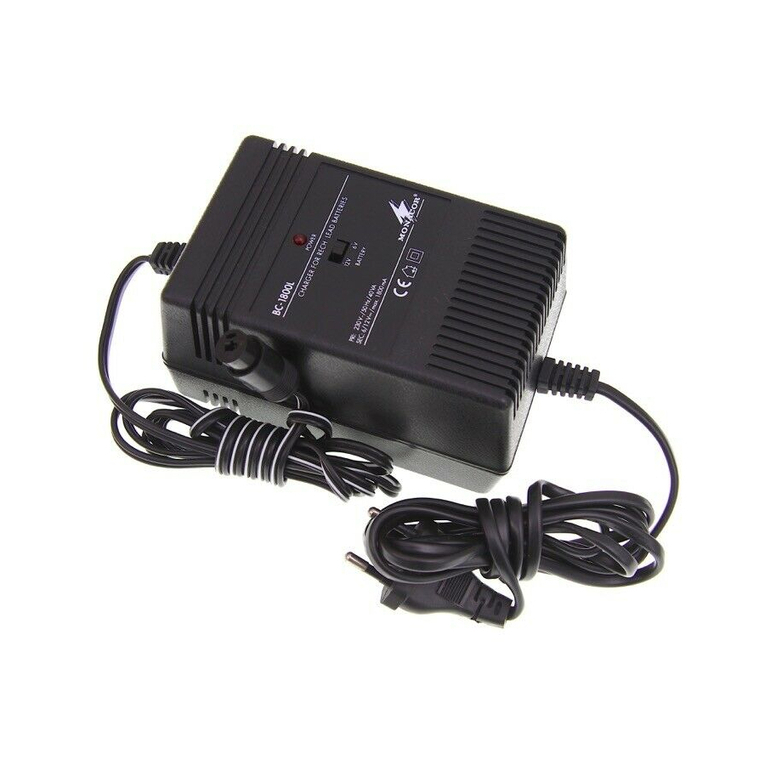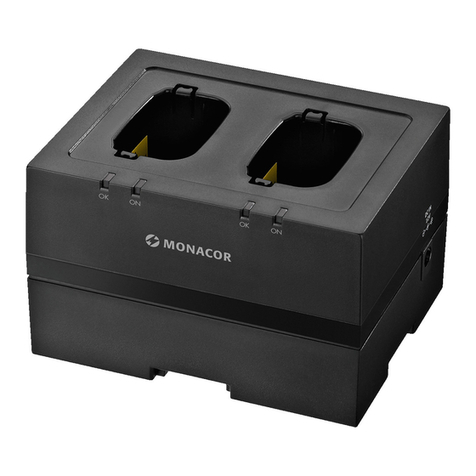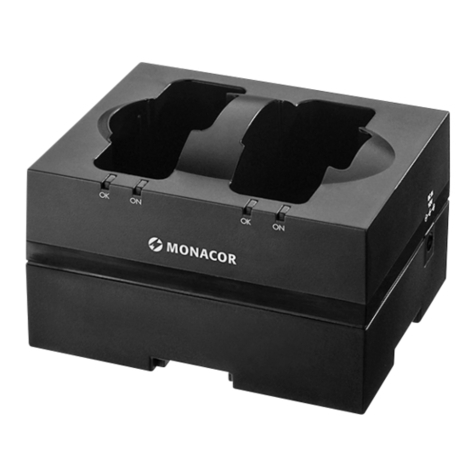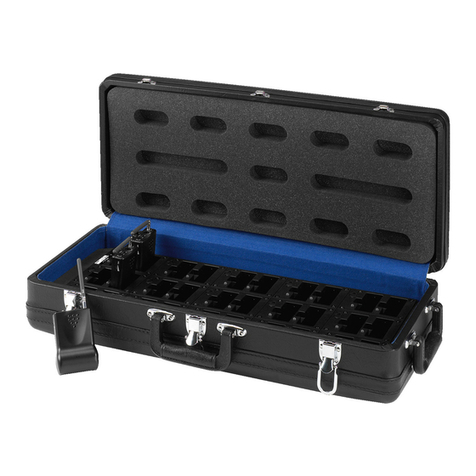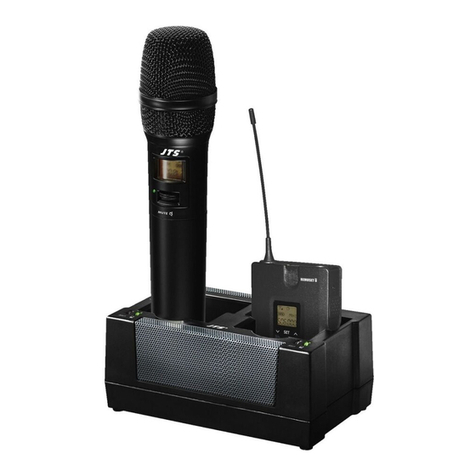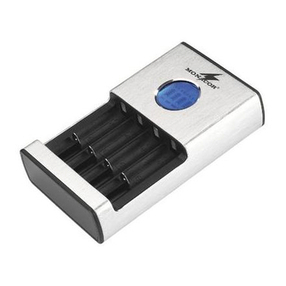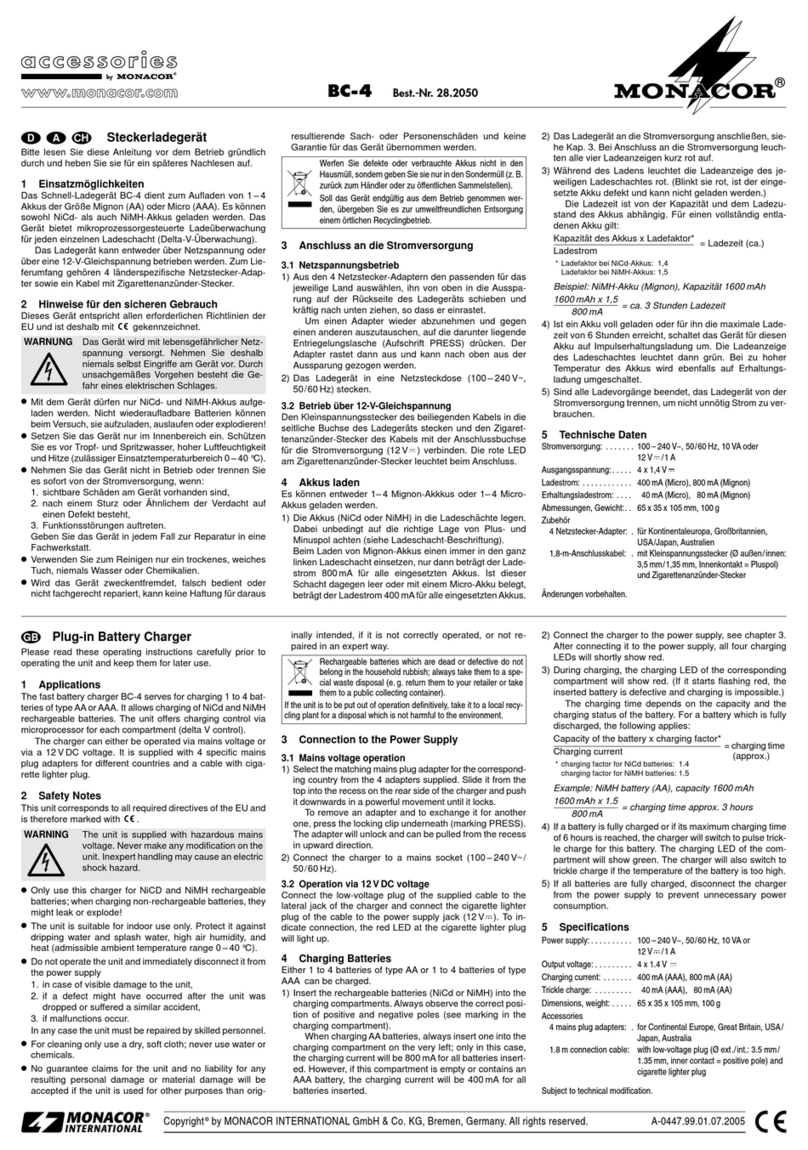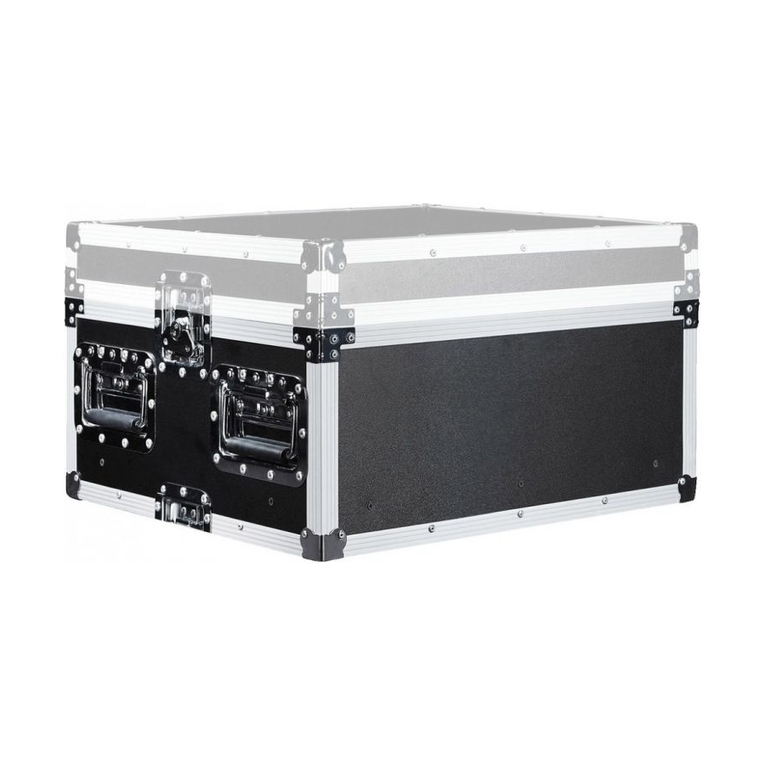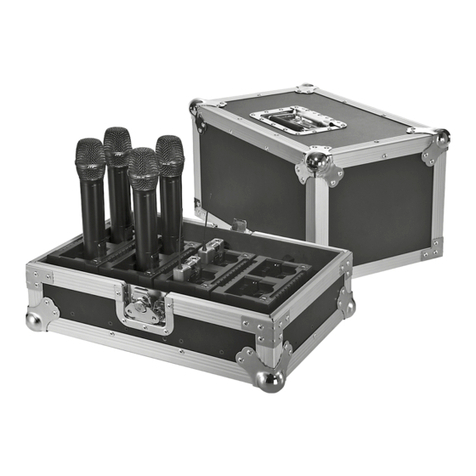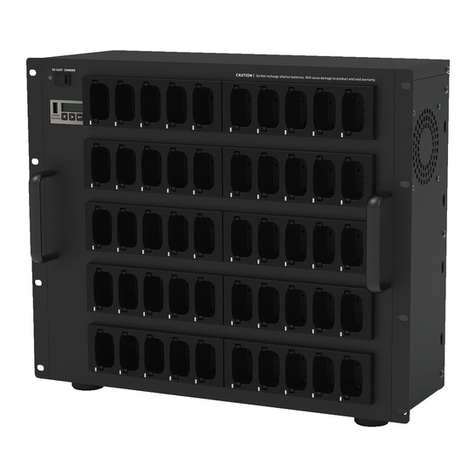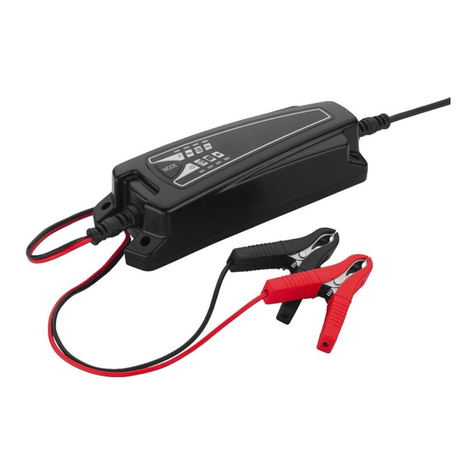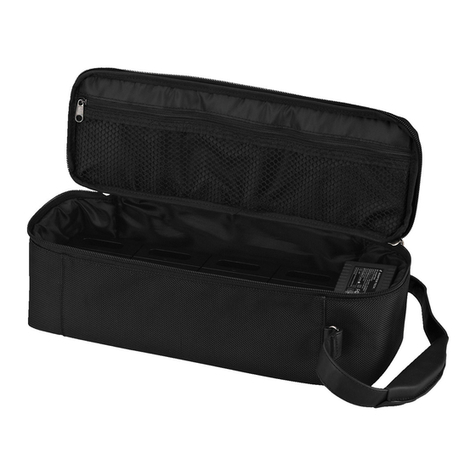
www.jts-europe.com
®
Vertrieb von JTS-Produkten – Distribution of JTS products
MONACOR INTERNATIONAL GmbH & Co. KG, Zum Falsch 36, 28307 Bremen, Germany
Copyright
©by MONACOR INTERNATIONAL. All rights reserved. A-1127.99.03.08.2017
Estas instrucciones van dirigidas a
usuarios sin ningún conocimiento téc-
nico específico. Lea atentamente estas
instrucciones antes de funcionamiento
y guárdelas para usos posteriores.
1 Aplicaciones
Este cargador se utiliza para recargar las baterías Li-Ion
de los emisores y receptores del sistema inalámbrico
TG-10. Pueden recargarse las baterías de dos unidades
al mismo tiempo.
Para recargar las baterías, inserte los emisores/re-
ceptores en los compartimentos de carga. El diseño
de los compartimentos de carga asegura la correcta
inserción de los aparatos, evitando errores en la pola-
ridad. Los circuitos de protección están provistos para
prevenir daños en las baterías, por ejemplo por una
sobrecarga.
2 Notas de Seguridad
Los aparatos (estación de carga y alimentador) cum-
plen con todas las directivas relevantes de la UE y por
lo tanto están marcados con el símbolo .
ADVERTENCIA El alimentador utiliza un voltaje pe-
ligroso. Deje el mantenimiento en
manos del personal cualificado. El
manejo inexperto puede provocar
una descarga.
•
Los aparatos están adecuados para su aplicación
sólo en interiores. Protéjalos contra goteos, salpi-
caduras y humedad elevada. Rango de temperatura
ambiente admisible: 0– 40ºC.
•
No coloque ningún recipiente con líquido encima de
los aparatos, p.ej. un vaso.
•
El calor generado en el interior de la estacíon de
carga tiene que disiparse con la circulación del aire.
Así pues, no cubra las rejillas de ventilación de la
carcasa.
•
Desconecte inmediatamente el alimentador de la
toma si:
1. El alimentado o la estación de carga están visi-
blemente dañados.
2. El aparato ha sufrido daños después de una caída
o accidente similar.
3. No funciona correctamente.
Sólo el personal técnico puede reparar los aparatos
bajo cualquier circunstancia.
•
Utilice sólo un paño suave y seco para la limpieza;
no utilice nunca ni agua ni productos químicos.
•
No podrá reclamarse garantía o responsabilidad
alguna por cualquier daño personal o material re-
sultante si los aparatos se utilizan para otros fines di-
ferentes a los originalmente concebidos, si no se uti-
lizan adecuadamente o no se reparan por expertos.
Si va a poner los aparatos fuera de servicio
definitivamente, llévelos a la planta de reci-
claje más cercana para que su eliminación
no sea perjudicial para el medioambiente.
3 Cargar las Baterías
1)
Conecte el alimentador a la toma de la parte
posterior de la estación de carga y a un enchufe
(230V/50 Hz). De este modo, se conecta la estación.
Mientras un compartimento de carga esté vacío, su
LED de carga se mantendrá parpadeando.
2)
Inserte el emisor/receptor, con sus contactos de
carga mirando hacia abajo, en uno de los compar-
timentos de carga. Cuando lo inserte, empuje el
aparato hacia el compartimento para asegurar un
buen encaje. Durante la carga, se iluminará el LED
de carga del compartimento permanentemente.
3) Cuando la batería del aparato esté completamente
cargada, se apagará el LED de carga correspon-
diente. El aparato puede sacarse del compartimento.
4)
Después de la carga, desconecte el alimentador
de la toma de corriente para prevenir un consumo
innecesario.
Nota: Si un LED de carga empieza a parpadear mientras la
carga está en proceso, la estacíon de carga hará un autotest
para proteger la batería.
4 Especificaciones
Tiempo de carga: . Hasta 8 horas aprox. (depen-
diendo del estado de la batería)
Alimentación: . . . . 12V (⎓) /0,6A mediante alimen-
tador entregado y conectado a
100– 240V, 50/60Hz
Dimensiones
(B × H × P):. . . . . . 75 × 41 × 85 mm
Peso total:. . . . . . . 485g
Sujeto a modificaciones técnicas.
TG-10CH2
Réf. num. • Ref. núm. 25.2670
Station de charge pour les récepteurs
et les émetteurs du système TG-10
Estación de carga para receptores y
emisores del sistema TG-10
Cette notice s’adresse aux utilisateurs
sans connaissances techniques parti-
culières. Veuillez lire avec attention
la notice avant le fonctionnement et
conservez-la pour pouvoir vous y re-
porter ultérieurement.
1 Possibilités d’utilisation
Ce chargeur permet de charger les accumulateurs
Lithium-ion des émetteurs et récepteurs du système
sans fil TG-10. Il est possible de charger simultané-
ment les accumulateurs de deux appareils.
Pour charger les accumulateurs, les émetteurs/les
récepteurs se placent dans les compartiments de
charge. Ils sont configurés de telle sorte qu’un posi-
tionnement incorrect des appareils et donc une inver-
sion de polarité involontaire sont exclus. Les circuits de
protection évitent tout dommage aux accumulateurs
(p.ex. par surcharge).
2 Conseils d’utilisation et de sécurité
Les appareils (station de charge et bloc secteur) ré-
pondent à toutes les directives nécessaires de l’Union
européenne et porte donc le symbole .
AVERTISSEMENT Le bloc secteur est alimenté par
une tension dangereuse. Ne tou-
chez jamais l’intérieur de l’appa-
reil ! En cas de mauvaise mani-
pulation, vous pourriez subir une
décharge électrique.
•
Les appareils ne sont conçus que pour une utilisa-
tion en intérieur. Protégez-les des éclaboussures, de
tout type de projections d‘eau et d’une humidité
d‘air élevée. La plage de température ambiante ad-
missible est de 0– 40°C.
•
En aucun cas, vous ne devez poser d’objet conte-
nant du liquide ou un verre sur les appareils.
•
La chaleur dégagée par la station de charge doit être
évacuée par une circulation d’air correcte. En aucun
cas, les ouïes de ventilation du boîtier ne doivent
être obturées.
•
Débranchez immédiatement le bloc secteur lorsque:
1. des dommages visibles apparaissent sur la station
de charge ou sur le bloc secteur,
2. après une chute ou un cas similaire, vous avez un
doute sur l’état de l’appareil,
3. des dysfonctionnements apparaissent.
Dans tous les cas, les dommages doivent être répa-
rés par un technicien spécialisé.
•
Pour nettoyer, utilisez uniquement un chiffon sec et
doux, en aucun cas de produits chimiques ou d’eau.
•
Nous déclinons toute responsabilité en cas de dom-
mages matériels ou corporels résultants si les appa-
reils sont utilisés dans un but autre que celui pour le-
quel ils ont été conçus, s’ils ne sont pas correctement
utilisés ou ne sont pas réparés par une personne
habilitée, en outre, la garantie deviendrait caduque.
Lorsque les appareils sont définitivement
retirés du service, vous devez les déposer
dans une usine de recyclage adaptée pour
contribuer à leur élimination non polluante.
CARTONS ET EMBALLAGE
PAPIER À TRIER
3 Chargement des accumulateurs
1) Reliez le bloc secteur à la prise sur la face arrière de
la station de charge et à une prise 230V/50Hz. La
station est alors allumée. Tant qu‘un compartiment
de charge est vide, son témoin de fonctionnement
clignote.
2)
Placez l’émetteur/le récepteur dans un comparti-
ment de charge, contacts de charge orientés vers le
bas. Lorsque vous le positionnez, veillez à enfoncer
complètement l’appareil dans le compartiment pour
qu’il soit bien fixe. Pendant la charge, le témoin de
fonctionnement du compartiment de charge brille
en continu.
3)
Lorsque l’accumulateur est totalement chargé, le
témoin de charge correspondant s’éteint. L’appareil
peut alors être retiré du compartiment de charge.
4) Après la charge, débranchez le bloc secteur pour
éviter toute consommation inutile de courant.
Remarque : Si un témoin de charge clignote pendant la
charge, la station de charge effectue un auto-test pour pro-
téger l’accumulateur.
4 Caractéristiques techniques
Durée de charge : . 8 heures max. environ (selon
l’état de charge de l’accumula-
teur)
Alimentation :. . . . 12V (⎓) /0,6A par bloc secteur
livré relié à 100– 240V, 50/60Hz
Dimensions
(l × h × p) : . . . . . . 75 × 41 × 85 mm
Poids total :. . . . . . 485g
Tout droit de modification réservé.
ESPAÑOL
FRANÇAIS
